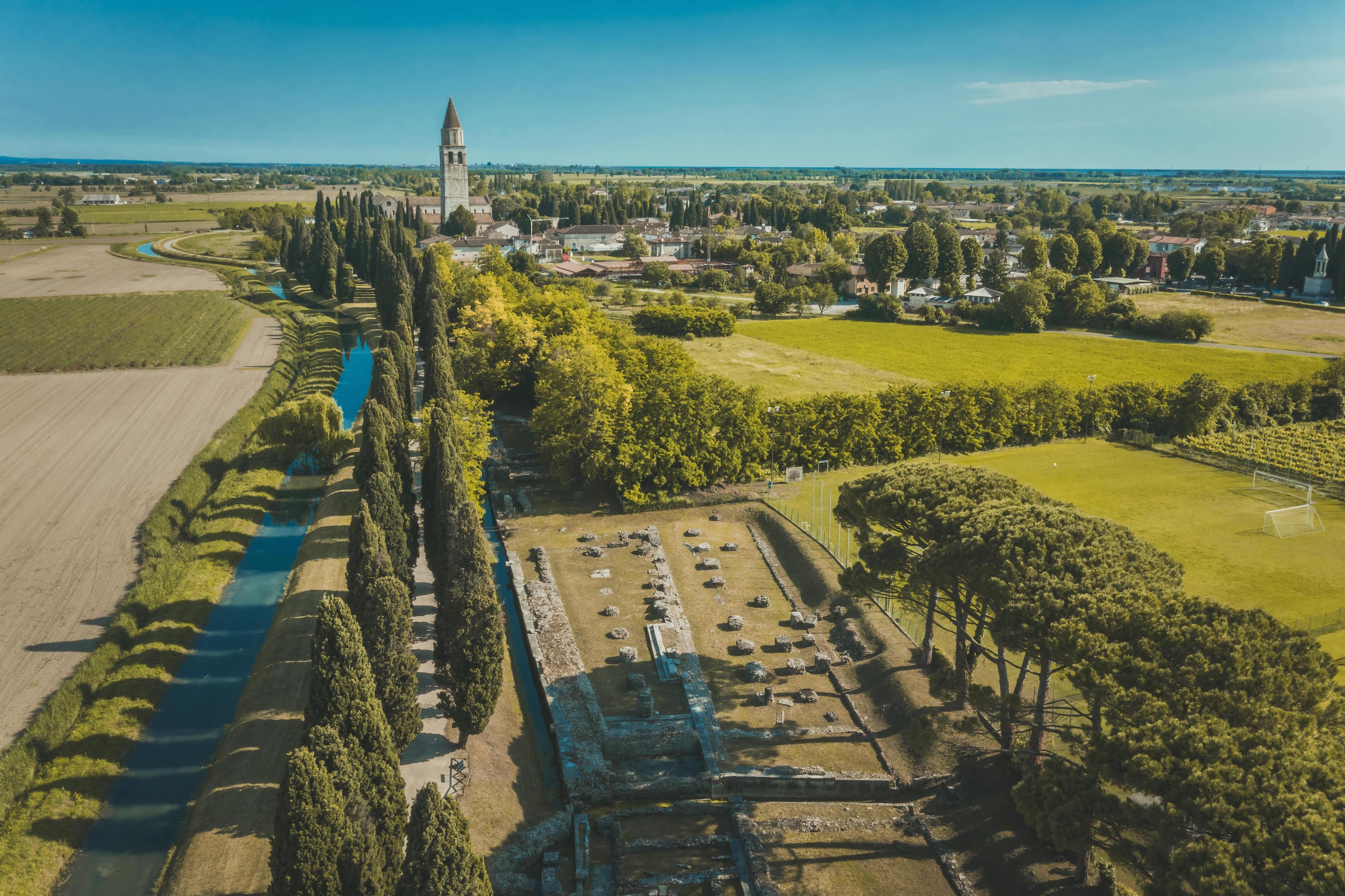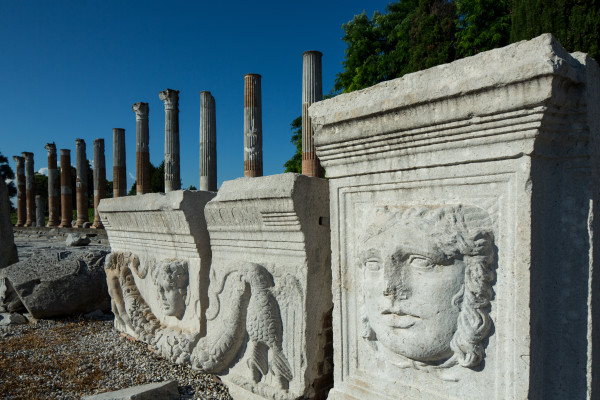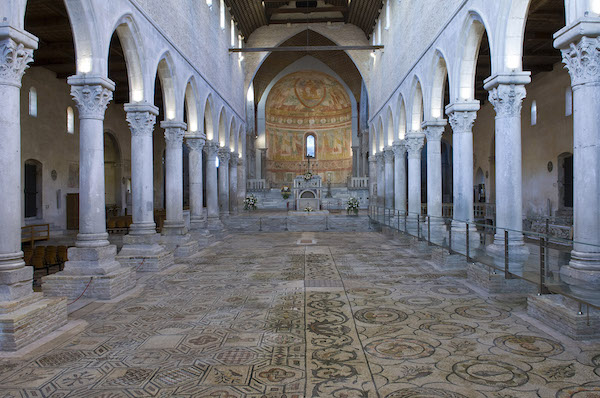AQUILEIA
PATRIMONIO DELL'UMANITÀ
lunedì 5 gennaio 2026
Secrets and splendors of the UNESCO site
“Travel with us through the history of Aquileia”, the new guided tour to discover the ancient city
The Columns of the the Court of Aquileia | © Fondazione Aquileia
Francesca Grego - 21/03/2024
Immerse yourself in a two thousand year history, among the stones of what was one of the most flourishing and strategic cities of the Roman Empire: the invitation comes from Aquileia, which welcomes spring with a new, stimulating program of guided visits to the its archaeological remains. An ancient crossroads of peoples, goods, languages and cultures thanks to its border position, Aquileia hosts the most complete example of a Roman city existing today in the Mediterranean basin: an extraordinary treasure recognized by UNESCO as a World Heritage Site, concentrated in a The area is not too large and easily accessible, yet very rich in testimonies ranging from the splendors of the Empire to the early Christian and medieval era.
Before visiting the museums and mosaic domus, an outdoor walk among the key places of the ancient city is ideal for understanding its essence: this is the proposal of the guided tour "Travel with us in the history of Aquileia", dedicated to visitors of all ages and can be booked on the website https://www.turismofvg.it. The route is designed to offer an overall overview of the golden age of Aquileia, founded by the Romans as an outpost with a view to expansion towards the East, and prospered thanks to its role as a port and commercial hub between the routes of the East, Continental Europe and the Mediterranean.

Aquileia, Ancient River Port. Photo N. Oleotto
Monuments with a layered history, ancient streets and illuminated excavations mark a fascinating journey through time, from the Roman decumanus to the columns of the Forum, the beating heart of the political, economic and social life of the city in the imperial era, up to the River Port, built on the ancient course of the Torre and Natisone rivers, which today represents one of the best preserved examples of a Roman port structure.

Aquileia, Roman Forum I Courtesy Turismo FVG
Finally, the area of the Basilica, Domus and Episcopal Palace, in the heart of the city, is unmissable for anyone visiting Aquileia: here the testimonies of the past overlap, offering a glimpse of the evolution of Aquileia over time. In the same site it is in fact possible to observe the remains of a 1st century domus, a large apsidal hall from the early Christian era and what in the 5th century was the residence of the bishop of Aquileia, seat of a powerful Patriarchate. The leitmotif of the visit are the precious mosaics, the art for which the city was renowned: the immense Patriarchal Basilica is adorned with a mosaic floor of 760 square metres, the largest and oldest Christian mosaic in the West.

Aquileia, Patriarchal Basilica. Photo G. Baronchelli
Read also:
• Among the treasures of Aquileia. Guided tours of the UNESCO heritage pearl start again
Before visiting the museums and mosaic domus, an outdoor walk among the key places of the ancient city is ideal for understanding its essence: this is the proposal of the guided tour "Travel with us in the history of Aquileia", dedicated to visitors of all ages and can be booked on the website https://www.turismofvg.it. The route is designed to offer an overall overview of the golden age of Aquileia, founded by the Romans as an outpost with a view to expansion towards the East, and prospered thanks to its role as a port and commercial hub between the routes of the East, Continental Europe and the Mediterranean.

Aquileia, Ancient River Port. Photo N. Oleotto
Monuments with a layered history, ancient streets and illuminated excavations mark a fascinating journey through time, from the Roman decumanus to the columns of the Forum, the beating heart of the political, economic and social life of the city in the imperial era, up to the River Port, built on the ancient course of the Torre and Natisone rivers, which today represents one of the best preserved examples of a Roman port structure.

Aquileia, Roman Forum I Courtesy Turismo FVG
Finally, the area of the Basilica, Domus and Episcopal Palace, in the heart of the city, is unmissable for anyone visiting Aquileia: here the testimonies of the past overlap, offering a glimpse of the evolution of Aquileia over time. In the same site it is in fact possible to observe the remains of a 1st century domus, a large apsidal hall from the early Christian era and what in the 5th century was the residence of the bishop of Aquileia, seat of a powerful Patriarchate. The leitmotif of the visit are the precious mosaics, the art for which the city was renowned: the immense Patriarchal Basilica is adorned with a mosaic floor of 760 square metres, the largest and oldest Christian mosaic in the West.

Aquileia, Patriarchal Basilica. Photo G. Baronchelli
Read also:
• Among the treasures of Aquileia. Guided tours of the UNESCO heritage pearl start again
Spotlight
See allFrom Salento to Aquileia, a bridge of folk music
The project "From Salento to Aquileia" is starting in Aquileia, promoted by the La Notte della Taranta Foundation in collaboration with the Aquileia FoundationNews
See all
| Scoperte archeologiche ad Aquileia
Aquileia, the “Floral Carpet” Re-emerges: A Mosaic That Redraws a Roman Domus
Rediscovered near the Forum, the celebrated “Floral Carpet” mosaic—linked to the Cassis plots—may have belonged to a grand 4th-century residence.
Udine | New discoveries from the Ex Pasqualis site
Three ancient coins emerge from the soil of Aquileia, revealed by recent excavations
The recent excavation campaign has brought to light three gold coins of the emperors Valens, Magnus Maximus, and Arcadius, which had been hidden for centuries beneath the floor of a marketplace portico.
Udine | Saturday, October 18th at 6:30 PM in Aquileia


